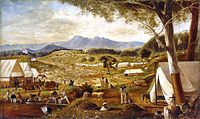
Photo from wikipedia
Abstract The antimony-gold deposits at Costerfield are a swarm of ‘dyke-like’ antimony-gold lodes within a brittle transpressional fault system. They are hosted in the Lower Silurian sedimentary rocks of the… Click to show full abstract
Abstract The antimony-gold deposits at Costerfield are a swarm of ‘dyke-like’ antimony-gold lodes within a brittle transpressional fault system. They are hosted in the Lower Silurian sedimentary rocks of the Melbourne Zone of the Lachlan Orogen. Individual lodes are dominated by stibnite or stibnite-gold and widths vary from 1 cm to ∼200 cm (averaging 30 cm) and lengths can exceed 1 km. Lodes occur as fault-parallel layers or lenses mantled by deformed quartz-rich margins or overgrowths of hydrothermal quartz and carbonate. Inclusions in the stibnite-rich lodes include vuggy randomly oriented prismatic crystals, crack-sealed and stretched quartz with sugary mosaics of equant quartz grains and quartz breccias. Randomly oriented quartz and stibnite textures, common in the centre of the lodes, indicate free growth from a fluid. Throughout the mineralized system, the hydrothermal stibnite has replaced and overgrown the earlier quartz. Deformed lode margins preserve sub-horizontal lineations and evidence of oblique crack-seal re-opening that reflect emplacement associated with late sinistral strike-slip movements in bounding faults. Crystallographic orientation data collected from the marginal quartz, using neutron diffraction and supported by microstructural observations, reveal that lode emplacement also involved dissolution-precipitation creep and pressure solution. Both the marginal quartz and the lodes are overprinted by later microfractures, within which there has been precipitation of stibnite, pyrite, arsenopyrite, sphalerite and minor gold. 3 D neutron tomography revealed individual gold crystals, with gold voxel sizes ranging from 140 µm to ∼580 µm, were located in late arsenopyrite-gold domains that overprint the stibnite. The mechanical evolution of the lodes involved short-lived brittle processes in combination with dissolution-precipitation crystallization in active fault zones. These ore bodies provide insights about the dynamics of fluid flow and flow velocities when faults breach over-pressured reservoirs of hydrothermal fluid. Our results also suggest that the Costerfield deposit was formed directly from metal-rich metamorphic fluids produced during Tabberabberan (∼375 Ma) prograde metamorphism of sedimentary rocks near the base of the Lower Paleozoic Melbourne Zone, which lie above the Proterozoic Selwyn Block. From a reinterpretation of seismic reflection data, the deformation in the Melbourne Zone sedimentary wedge is characterized by thrusts isolating relatively undeformed packages of sedimentary units, which were moved in a piggyback manner up west-dipping faults. The ore-bearing fluids migrated upwards, at least in part, along these footwall thrusts from the base of the Heathcote Fault Zone. In the upper levels of the sedimentary package, out-of-sequence strike-slip, sub-vertical splays from these second order faults carried the mineralizing fluids to the orebodies. East-west compression during the Tabberabberan Orogeny preceded a northwest-southeast-oriented stress field which reflects the collision of VanDieland against the Gondwanan margin. This produced the sinistral strike-slip faults, which in turn controlled the overall permeability of the hydrothermal system.
Journal Title: Ore Geology Reviews
Year Published: 2017
Link to full text (if available)
Share on Social Media: Sign Up to like & get
recommendations!